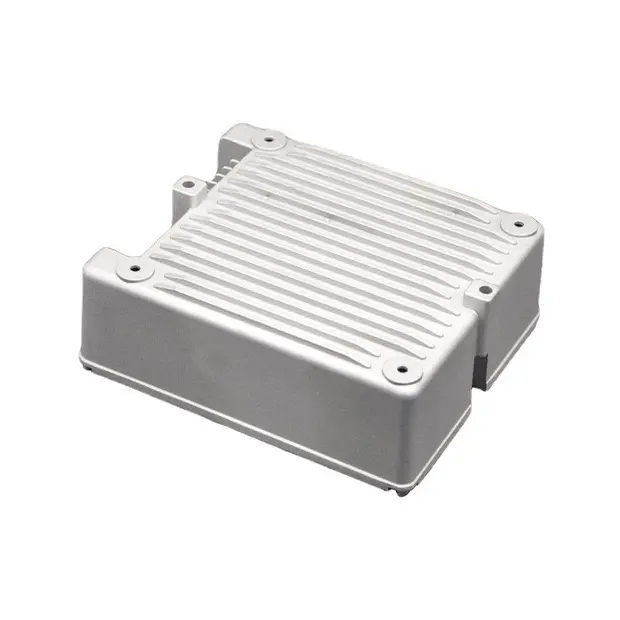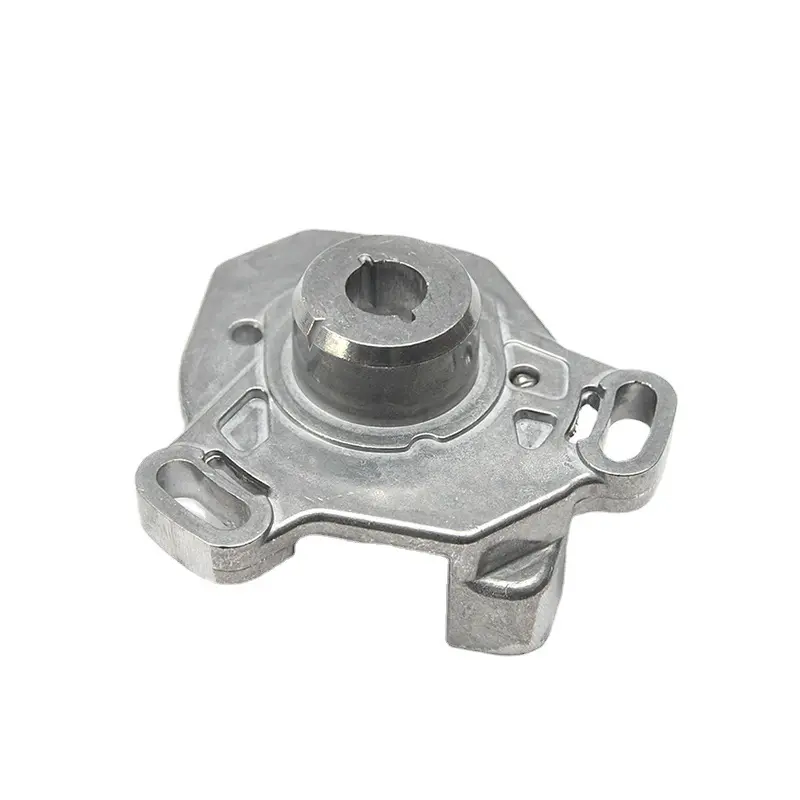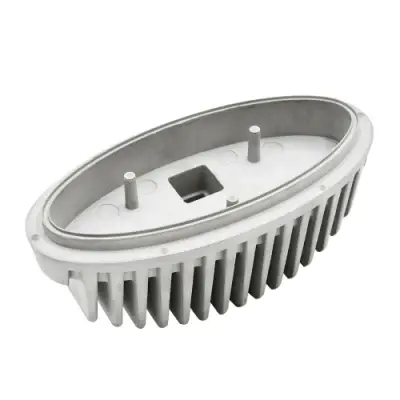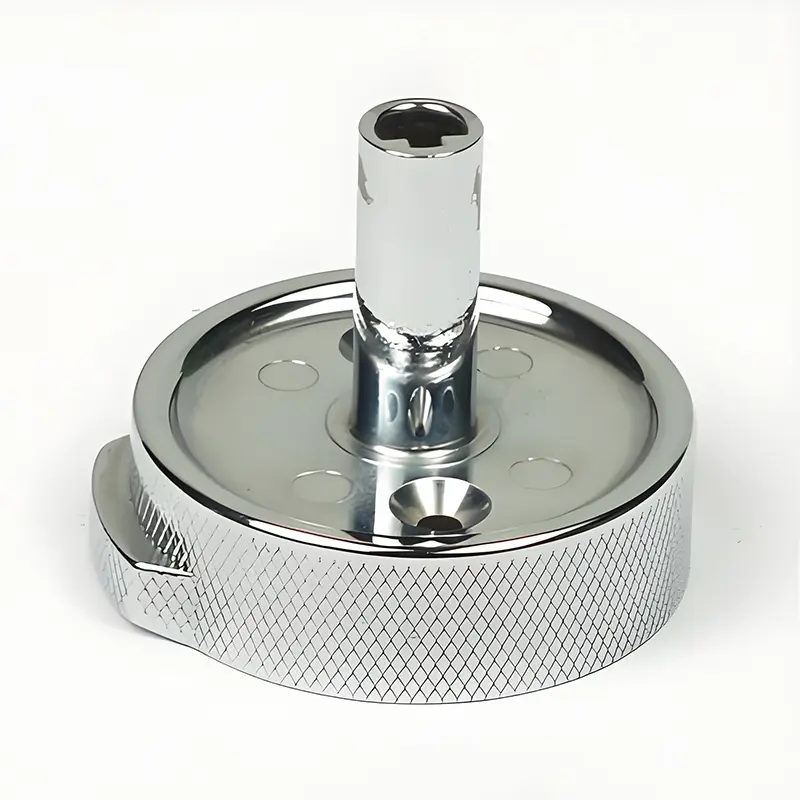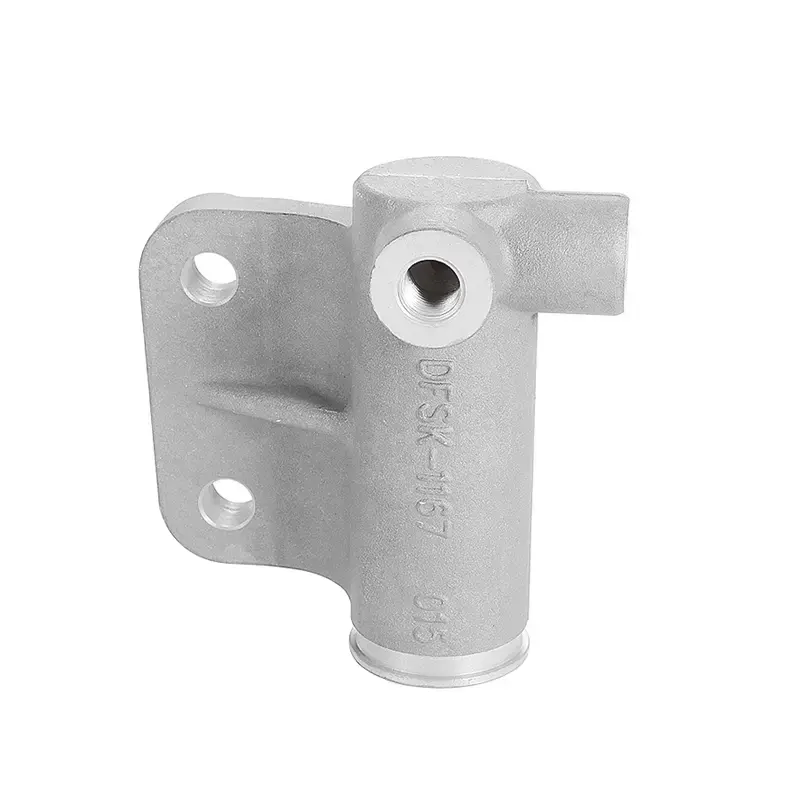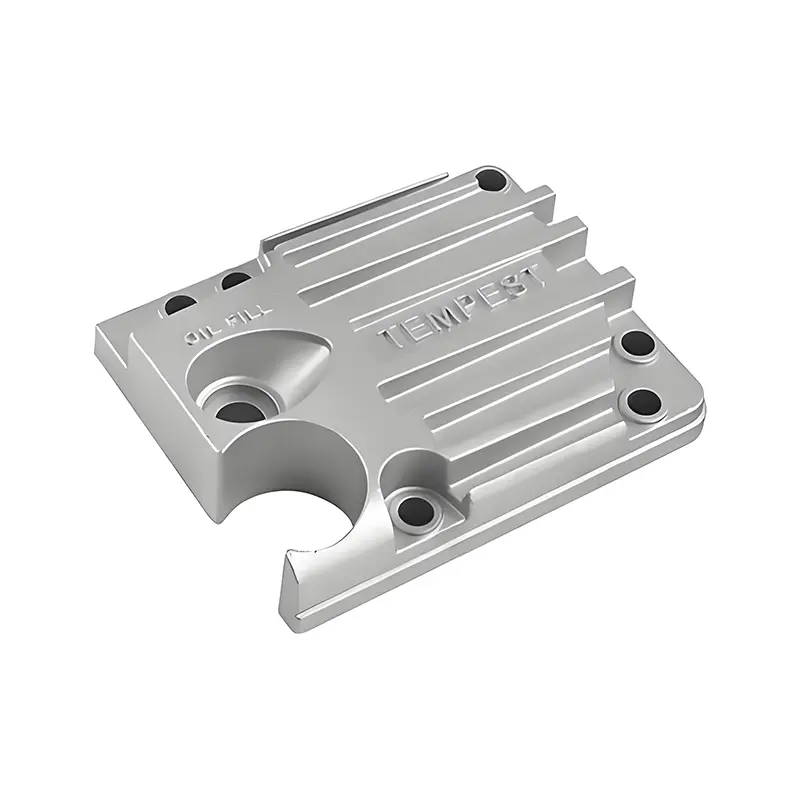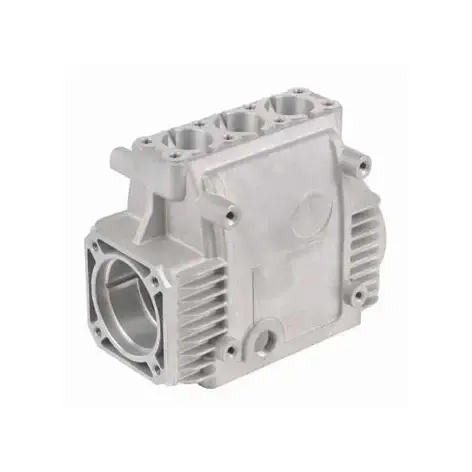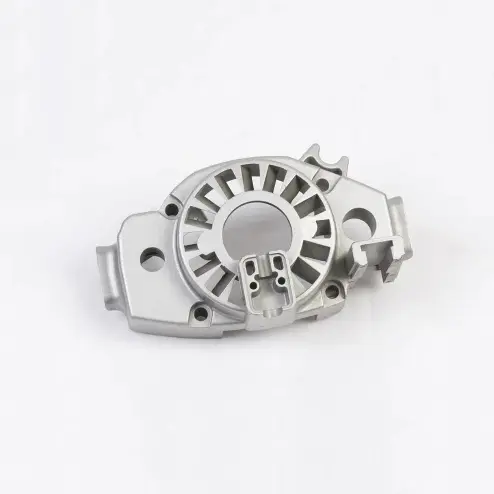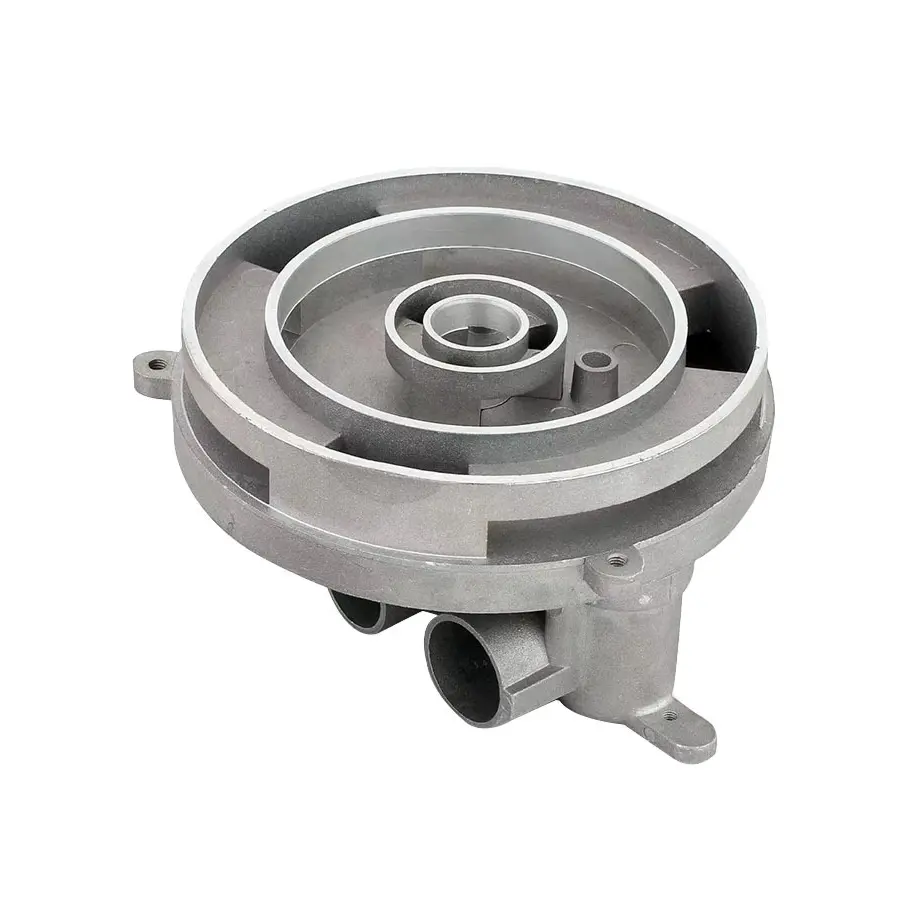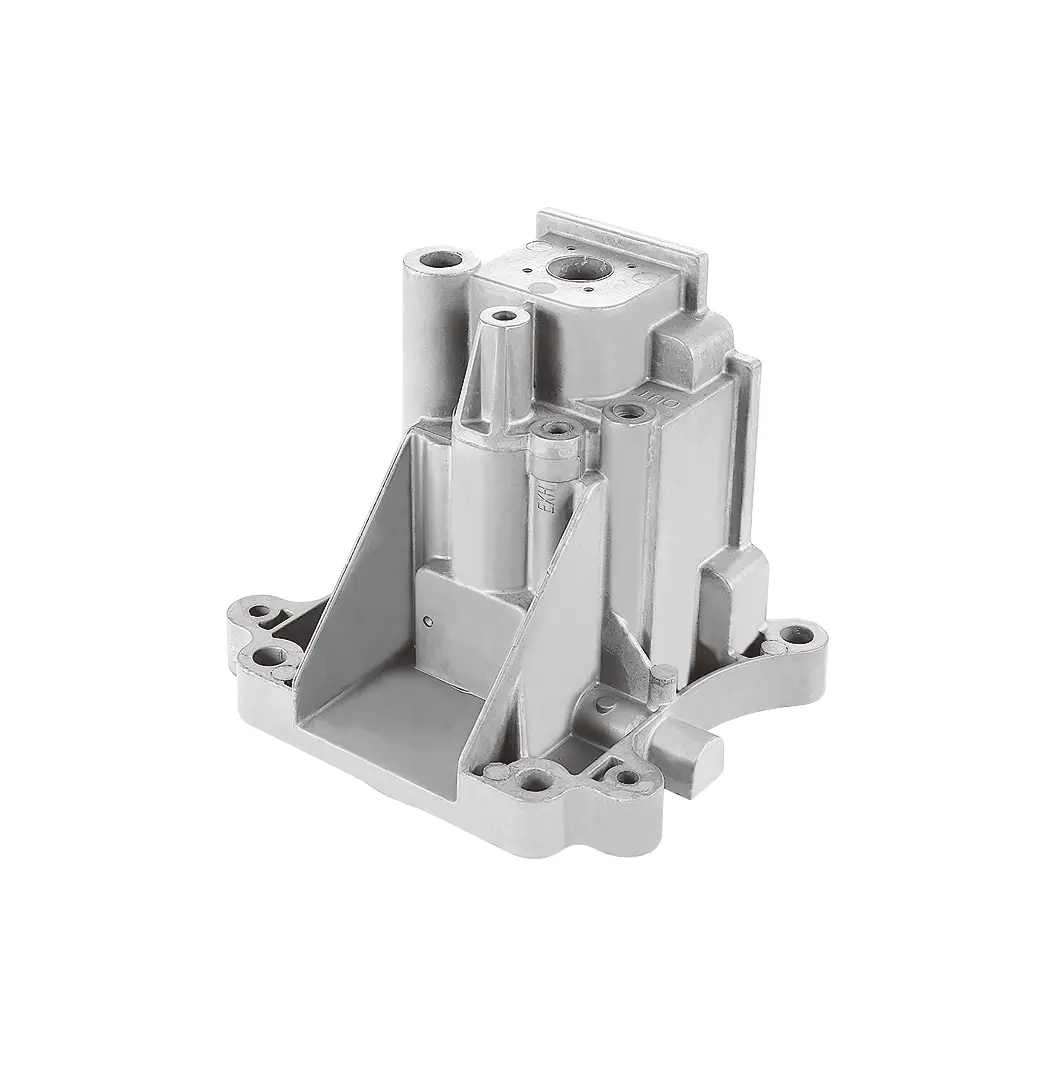 +86-13516964051
+86-13516964051 Aluminum alloy low-pressure casting
1. Overview of aluminum alloy low-pressure casting technology
1.1 Definition and principle
Aluminum alloy low-pressure casting is an advanced Casting Technology between gravity casting and high-pressure casting. It allows the liquid aluminum alloy to slowly rise under pressure and fill the mold cavity under low pressure (usually 0.02-0.06MPa), and then solidify under pressure. The principle is to use low pressure to make the molten metal rise steadily under pressure, avoiding turbulence and air entrainment during the filling process, so as to obtain castings with dense structure and good surface quality. This technology has been widely used in fields such as automobiles and aerospace that have high requirements for casting quality. For example, in the production of key components such as automobile engine cylinder blocks and cylinder heads, low-pressure casting technology can significantly improve the mechanical properties and dimensional accuracy of castings and reduce scrap rates.
2. Process flow and key parameters
2.1 Process flow breakdown
The process flow of aluminum alloy low-pressure casting mainly includes the following steps:
Preparation stage: First, the mold needs to be preheated. The preheating temperature is usually between 200-300℃ to ensure that the molten metal will not cool too quickly during the filling process due to the low mold temperature, which will affect the filling effect. At the same time, the molten metal is refined to remove impurities and gases to ensure the purity of the molten metal. For example, by using refining agents and degassing equipment, the hydrogen content in the molten metal can be reduced to below 0.1-0.2ml/100gAl, effectively reducing the porosity defects in the casting.
Filling stage: The preheated mold is installed on the low-pressure casting machine, and then the molten metal is poured from the pouring cup into the riser. Under the action of low pressure, the molten metal slowly rises along the riser and fills the casting cavity. The filling speed is generally controlled at 0.05-0.2m/s to ensure that the molten metal rises smoothly and avoids turbulence and air entrainment. For example, when producing automobile engine cylinder blocks, by precisely controlling the filling speed, the surface quality of the casting can reach Ra0.8 - 1.6μm, meeting the quality requirements of the automotive industry.
Solidification stage: After the molten metal fills the cavity, continue to maintain a certain pressure to solidify the casting under pressure. The solidification time depends on the size and shape of the casting, generally ranging from a few minutes to more than ten minutes. During the solidification process, the maintenance of pressure helps the molten metal to supplement the shrinkage and reduce shrinkage and shrinkage defects. For example, for large aerospace castings, the solidification time may be as long as 30-40 minutes to ensure that the internal structure of the casting is dense.
Mold opening and removal stage: After the casting solidifies, stop applying pressure, open the mold, and remove the casting. At this time, the temperature of the casting is still high, and appropriate cooling treatment, such as air cooling or water cooling, is required to prevent the casting from deformation or cracking during the cooling process. For example, for some thin-walled castings, air cooling can avoid cracks caused by excessive cooling speed.
2.2 Key parameter control
In the process of aluminum alloy low-pressure casting, the control of key parameters has a vital impact on the quality of castings:
Pressure control: The pressure of low-pressure casting is one of the core parameters that affect the quality of castings. It is generally divided into filling pressure and holding pressure. The filling pressure is usually controlled at 0.02-0.06MPa, and the holding pressure is adjusted according to the size and complexity of the casting, generally between 0.05-0.1MPa. For example, when producing automobile engine cylinder heads, the filling pressure is selected to be 0.04MPa and the holding pressure is 0.08MPa, which can effectively ensure the filling integrity and internal quality of the casting and make the density of the casting reach more than 98%.
Temperature control: including molten metal temperature and mold temperature. The molten metal temperature is generally controlled at 650-750℃. Too high temperature will cause oxidation and air inhalation of the molten metal, and too low temperature will affect the filling effect. The mold temperature is usually preheated to 200-300℃ and remains relatively stable during the production process. For example, when producing Aluminum Alloy Castings for aerospace, the mechanical properties of the castings can be significantly improved by precisely controlling the temperature of the molten metal and the mold temperature, with a tensile strength of 300-350MPa and an elongation of 3%-5%.
Filling speed control: Reasonable control of the filling speed can avoid turbulence and air entrainment of the molten metal during the filling process. It is generally controlled at 0.05-0.2m/s. For example, when producing automobile wheels, by optimizing the filling speed, the surface quality of the casting can reach Ra1.6-3.2μm, while reducing the generation of pore defects and improving the overall quality of the casting.
Solidification time control: The length of the solidification time directly affects the internal quality and dimensional accuracy of the casting. For small castings, the solidification time is generally a few minutes; for large castings, the solidification time may be as long as ten minutes or even longer. For example, when producing large aerospace castings, by extending the solidification time to 30-40 minutes, shrinkage and shrinkage defects can be effectively reduced, making the internal structure of the casting denser and the dimensional accuracy within ±0.5mm.
3. Equipment and mold requirements
3.1 Characteristics of low-pressure casting equipment
Aluminum alloy low-pressure casting equipment is a key tool for realizing low-pressure casting process, and its design and performance directly affect the quality and production efficiency of castings.
Pressure control system: The equipment is equipped with a high-precision pressure control system that can accurately control the filling pressure and holding pressure. For example, the pressure control accuracy of modern low-pressure casting machines can reach ±0.001MPa, ensuring that the molten metal can rise smoothly during the filling process to avoid turbulence and air entrainment. This high-precision pressure control is essential for the production of high-quality complex castings such as automobile engine cylinder blocks.
Temperature control system: The equipment is equipped with an efficient temperature control system that can simultaneously control the molten metal temperature and the mold temperature. The control accuracy of the molten metal temperature is usually within ±5℃, and the preheating and holding accuracy of the mold temperature is within ±10℃. For example, when producing aluminum alloy castings for aerospace, precise temperature control can significantly improve the mechanical properties of castings, with tensile strength reaching 300-350MPa and elongation reaching 3%-5%.
Automation: Modern low-pressure casting equipment is highly automated and can realize the whole process of automated operation from metal liquid injection, mold filling, solidification to mold opening and taking out parts. The improvement of automation not only improves production efficiency, but also reduces the impact of human factors on casting quality. For example, the production efficiency of automated equipment is 30%-50% higher than that of traditional manual operation, and the scrap rate of castings is reduced to 2%-3%.
Safety performance: Low-pressure casting equipment is designed with full consideration of operational safety. The equipment is equipped with safety facilities such as emergency stop device, safety protection door and leakage detection system. For example, the safety protection door of the equipment is automatically closed during operation to prevent metal liquid from splashing and injuring people, and the leakage detection system can monitor the pressure and temperature inside the equipment in real time to ensure the safety of the operation process.
3.2 Mold design and material selection
The mold is the core component in the low-pressure casting process, and its design and material selection have an important impact on the quality and production cost of the casting.
Mold design: Mold design needs to comprehensively consider factors such as the shape, size, and wall thickness of the casting. For example, for the complex shape of the automobile engine cylinder head, the mold design adopts a block structure to facilitate the demolding of the casting and the maintenance of the mold. At the same time, the mold design also needs to consider the flow path of the molten metal, and reduce the defects of pores and slag inclusions by optimizing the design of the gate and exhaust system. For example, the optimized mold design can make the surface quality of the casting reach Ra0.8 - 1.6μm, which meets the quality requirements of the automotive industry.
Material selection: Mold materials are usually made of high-strength, high-temperature-resistant, and wear-resistant alloy steel. For example, H13 steel is a commonly used mold material with good thermal stability and thermal fatigue resistance, and can withstand repeated thermal shock and mechanical stress. When producing large aerospace castings, the service life of the mold material can reach 10,000 - 15,000 times, effectively reducing the production cost.
Surface treatment: The mold surface is usually specially treated, such as hard chrome plating, nitriding, etc., to improve the wear resistance and corrosion resistance of the mold. For example, the surface hardness of the mold after hard chrome plating can be increased to HRC60-65, and the service life can be extended by 20%-30%. At the same time, the adhesion phenomenon on the surface of the casting is reduced, and the surface quality of the casting is improved.
Mold manufacturing accuracy: The manufacturing accuracy of the mold directly affects the dimensional accuracy and surface quality of the casting. Modern mold manufacturing uses high-precision CNC machining equipment, and the dimensional accuracy of the mold can reach ±0.05mm, and the surface roughness can be controlled within Ra0.4-0.8μm. For example, when producing automobile wheels, high-precision mold manufacturing can make the dimensional accuracy of the casting reach within ±0.1mm and the surface quality reach Ra1.6-3.2μm, meeting the market demand for high-quality castings.
4. Advantages and Application Fields
4.1 Analysis of Process Advantages
Compared with traditional casting processes, aluminum alloy low-pressure casting technology has significant process advantages, which makes it popular in modern manufacturing.
High-quality castings: Low-pressure casting technology effectively avoids turbulence and air entrainment of molten metal during the filling process by smoothly filling and solidifying under pressure at a lower pressure, reducing defects such as pores, shrinkage and shrinkage in castings. For example, the density of automobile engine cylinder blocks produced by low-pressure casting can reach more than 98%, the mechanical properties are significantly improved, the tensile strength reaches 300-350MPa, the elongation reaches 3%-5%, and the scrap rate is reduced to 2%-3%.
High dimensional accuracy: The process can accurately control the filling speed and solidification time to ensure the dimensional accuracy of the casting. For example, when producing large aerospace castings, by extending the solidification time to 30-40 minutes, the dimensional accuracy of the casting can reach within ±0.5mm, meeting the high precision requirements.
High production efficiency: Modern low-pressure casting equipment is highly automated and can realize the whole process of automated operation from metal liquid injection, mold filling, solidification to mold opening and taking out parts. The production efficiency of automated equipment is 30% - 50% higher than that of traditional manual operation, while reducing the impact of human factors on the quality of castings.
High material utilization rate: During the low-pressure casting process, the molten metal slowly rises and fills the cavity under pressure, reducing the splashing and waste of molten metal. For example, when producing automobile wheels, the material utilization rate can be increased by 15% - 20%, reducing production costs.
Strong adaptability: This process is suitable for the production of castings of various aluminum alloy materials and complex shapes, from thin-walled castings to large thick-walled castings. For example, for thin-walled automobile wheels and large aerospace castings, low-pressure casting can meet their quality and performance requirements.
4.2 Expansion of application fields
Aluminum alloy low-pressure casting technology has been widely used in many fields due to its unique advantages, and new application directions are constantly being expanded.
Automobile industry: Key parts such as automobile engine cylinder blocks and cylinder heads are the main application objects of low-pressure casting technology. For example, more than 70% of global automobile manufacturers use low-pressure casting technology to produce engine cylinder blocks, and the improvement of the quality of their castings directly improves the performance and reliability of the engine. In addition, low-pressure casting is also widely used in the production of automobile wheels, which not only improves the strength and lightweight level of the wheels, but also reduces production costs.
Aerospace field: The aerospace field has extremely high requirements for the quality and performance of castings, and low-pressure casting technology can meet its demanding requirements. For example, when producing large aerospace castings, low-pressure casting technology can make the internal structure of the castings more compact, the dimensional accuracy can reach within ±0.5mm, and the mechanical properties are significantly improved. According to statistics, aerospace castings produced by low-pressure casting account for more than 40% of the total castings in this field, and this proportion is still growing.
Motorcycle industry: Low-pressure casting technology is also widely used in the production of motorcycle engine cylinder blocks, cylinder heads and wheels and other parts. For example, a well-known motorcycle manufacturer uses low-pressure casting technology to produce engine cylinders, and its product scrap rate is reduced to 2% - 3%, and production efficiency is increased by 30% - 50%, which significantly enhances the company's market competitiveness.
Machinery manufacturing industry: In the field of machinery manufacturing, low-pressure casting technology is used to produce aluminum alloy castings with various complex shapes and high performance requirements, such as hydraulic valve bodies, pump bodies, etc. For example, a machinery manufacturing company uses low-pressure casting technology to produce hydraulic valve bodies, and the density of its castings reaches more than 98%, the mechanical properties are significantly improved, and the service life is extended by 20% - 30%.
Emerging application fields: With the continuous advancement of technology, aluminum alloy low-pressure casting technology has also shown broad application prospects in emerging fields such as new energy vehicles and 5G communication equipment. For example, in the production of battery pack shells and motor housings of new energy vehicles, low-pressure casting technology can meet their lightweight and high-performance requirements, and improve the overall performance and endurance of new energy vehicles.
5. Quality control and defect prevention
5.1 Quality inspection methods
Quality inspection of aluminum alloy low-pressure casting is a key link to ensure that castings meet standards. The following methods are mainly used:
Non-destructive testing: including ultrasonic testing, radiographic testing (such as X-ray and CT scanning) and magnetic particle testing. Ultrasonic testing can detect defects such as cracks and shrinkage holes inside castings with a detection accuracy of up to millimeter level; radiographic testing can intuitively display the internal structure of castings, and has a significant effect on the detection of internal defects of complex-shaped castings; magnetic particle testing is mainly used to detect defects such as cracks on the surface or near the surface. For example, in the field of aerospace, CT scanning of large aluminum alloy castings can detect internal pores and inclusions with a diameter of less than 0.5mm, ensuring the high quality of castings.
Dimensional inspection: Use equipment such as three-coordinate measuring instruments and laser scanners to inspect the dimensional accuracy of castings. The measurement accuracy of the three-dimensional measuring machine can reach ±0.01mm, which can accurately measure the outer dimensions and internal structural dimensions of the casting; the laser scanner can quickly obtain the three-dimensional dimension data of the casting, compare it with the design model, and detect the dimensional deviation. For example, in the production of automobile engine cylinders, the three-dimensional measuring machine is used to detect the key dimensions of the cylinder body such as the bore diameter and hole spacing to ensure that its accuracy is within ±0.05mm to meet the assembly requirements.
Mechanical property testing: The mechanical properties of castings are tested by tensile tests, hardness tests and other methods. The tensile test can determine the tensile strength, yield strength and elongation of the casting; the hardness test is used to evaluate the hardness distribution on the surface and inside of the casting. For example, for aluminum alloy wheels produced by low-pressure casting, the tensile test results show that its tensile strength can reach 280-320MPa, the elongation is 3%-5%, and the hardness test results show that its surface hardness is between HRC30-35, which meets the use requirements.
Metallographic analysis: Observe the microstructure of the casting through a metallographic microscope to analyze the characteristics such as grain size and phase composition. Metallographic analysis can reveal problems that may occur during the solidification process of the casting, such as coarse grains and segregation. For example, when producing aluminum alloy castings for aerospace, metallographic analysis shows that the grain size is controlled between 50-100μm, the structure is uniform, and there is no obvious segregation, which helps to ensure the high performance of the casting.
5.2 Common defects and preventive measures
There are many defects that may occur during the low-pressure casting of aluminum alloys. These defects not only affect the appearance quality of the castings, but also may reduce their mechanical properties and service life. The following are common defects and their preventive measures:
Porosity defect: Porosity is one of the common defects in low-pressure casting of aluminum alloys, mainly caused by the entrapment of gas in the molten metal during the filling process or poor mold exhaust. Preventive measures include:
Optimize the filling speed and control it at 0.05-0.2m/s to avoid turbulence and entrainment of the molten metal.
Ensure that the mold exhaust system is unobstructed, and reasonably design the position and size of the exhaust groove and exhaust hole.
Fully refine the molten metal to remove impurities and gases, and control the hydrogen content below 0.1-0.2ml/100gAl.
Maintain the mold temperature at 200-300℃, reduce the cooling rate of the molten metal during the filling process, and avoid gas precipitation to form pores.
For example, in the production of automobile engine cylinders, by optimizing the filling speed and exhaust system design, the pore defect rate was reduced by more than 50%, and the density of the casting was significantly improved.
Shrinkage and shrinkage defects: These defects are caused by insufficient shrinkage compensation due to the volume shrinkage of the molten metal during solidification. Preventive measures include:
Reasonably control the holding pressure and solidification time to ensure that the molten metal can fully compensate for the shrinkage during the solidification process. For example, for large aerospace castings, the holding pressure is selected to be 0.08-0.1MPa, and the solidification time is extended to 30-40 minutes, which can effectively reduce shrinkage and shrinkage defects.
Optimize the structural design of castings to avoid concentrated shrinkage in thick and large parts, and adopt a reasonable pouring system and riser design to ensure the sequential solidification of molten metal.
Strictly control the temperature of molten metal and mold temperature to avoid oxidation and air inhalation of molten metal due to excessive temperature, which will affect the shrinkage compensation effect.
For example, in the production of automobile wheels, by optimizing the holding pressure and solidification time, the shrinkage cavity and shrinkage defect rate were reduced by 40%, and the internal structure of the casting was more compact.
Slag inclusion defect: Slag inclusion is formed when impurities or oxide scale in the molten metal are rolled into the casting during the filling process. Preventive measures include:
Fully refine the molten metal to remove impurities and oxide scale to ensure the purity of the molten metal.
Optimize the design of the pouring system to avoid turbulence and slag rolling of the molten metal during the filling process.
Reasonably control the pouring speed and filling speed to ensure that the molten metal rises smoothly and reduce the possibility of slag inclusion.
Use filtering devices such as filter screens to filter the molten metal to remove large particles of impurities and oxide scale.
For example, in the production of aluminum alloy wheels, the slag inclusion defect rate was reduced by 30% by using a filter and optimizing the pouring system design, and the surface quality and internal quality of the castings were significantly improved.
Surface defects: such as surface roughness, cold shut, flow marks, etc. These defects mainly affect the appearance quality and dimensional accuracy of the castings. Preventive measures include:
Optimize the filling speed and mold temperature to ensure that the molten metal can rise smoothly during the filling process and avoid cold shut and flow marks.
Keep the mold surface clean and in good lubrication condition, reduce the adhesion of the molten metal to the mold surface, and improve the surface quality of the casting.
Strictly control the purity of the molten metal to avoid the influence of impurities and gas on the surface quality of the casting.
Use high-precision mold manufacturing equipment to ensure that the dimensional accuracy and surface roughness of the mold meet the requirements.
For example, in the production of automobile engine cylinder heads, by optimizing the filling speed and mold temperature, the surface roughness can be controlled at Ra0.8 - 1.6μm, the cold shut and flow mark defect rate is reduced by 60%, and the appearance quality of the casting is significantly improved.
6. Development Trends and Technological Innovation
6.1 Technological Development Trends
Aluminum alloy low-pressure casting technology is developing in multiple directions to meet the growing market demand and higher quality requirements.
Intelligence and automation continue to improve: With the advancement of Industry 4.0, the intelligence and automation level of low-pressure casting equipment will be further improved. For example, by introducing advanced sensor technology and automated control systems, real-time monitoring and precise control of the casting process can be achieved, including automatic adjustment of key parameters such as pressure, temperature, and filling speed. This can not only improve production efficiency, but also further reduce the scrap rate and improve the stability of casting quality.
Green casting and energy saving and consumption reduction: Against the background of increasing global environmental awareness, low-pressure casting technology will pay more attention to green development. On the one hand, by optimizing process parameters and equipment design, energy consumption and exhaust emissions can be reduced; on the other hand, environmentally friendly mold materials and coatings are used to reduce pollution to the environment. For example, some new energy-saving low-pressure casting machines can reduce energy consumption by 20% - 30% by improving heating systems and insulation measures.
Application of high-performance aluminum alloy materials: In order to meet the higher requirements for casting performance in high-end fields such as aerospace and new energy vehicles, the research and development and application of high-performance aluminum alloy materials will become the focus of future development. For example, by adding specific alloying elements and optimizing heat treatment processes, aluminum alloy materials with higher strength, toughness and corrosion resistance are developed to further expand the application scope of low-pressure casting technology.
Production of complex structure castings: With the increasing complexity of product design, higher requirements are placed on the ability of low-pressure casting technology to produce complex structure castings. By improving mold design and filling technology, and optimizing the casting process with advanced computer simulation technology, high-quality production of castings with more complex shapes can be achieved. For example, using computer simulation technology to optimize the filling path and solidification process can effectively reduce defects in complex structure castings and improve their performance and reliability.
6.2 Application Cases of Innovative Technologies
Application of Intelligent Control Systems in Low-Pressure Casting: An automotive parts manufacturing company introduced an advanced intelligent control system for its aluminum alloy low-pressure casting production line. The system collects data such as pressure, temperature, and filling speed in the casting process in real time by installing multiple high-precision sensors on the mold and equipment, and analyzes and processes them through advanced algorithms to automatically adjust process parameters. For example, when producing automobile engine cylinder blocks, the intelligent control system can automatically optimize the filling speed and holding pressure based on real-time data, reducing the scrap rate of castings by 30%, increasing production efficiency by 20%, and significantly improving the mechanical properties of castings, with tensile strength increased by 10% - 15%.
Practice of green casting technology: An aerospace parts manufacturer is committed to the research and development and application of green casting technology. They use a new type of environmentally friendly mold coating that has good demoulding performance and high temperature resistance, while reducing the harmful gas emissions generated by traditional coatings during use. In addition, the company has also carried out energy-saving transformation of low-pressure casting equipment, reducing the energy consumption of equipment by 25% by optimizing the heating system and using efficient insulation materials. When producing large aerospace castings, the application of green casting technology not only reduces production costs, but also improves the quality and surface finish of castings, meeting the strict requirements of the aerospace field.
Development and application of high-performance aluminum alloy materials: A new energy vehicle manufacturer cooperated with a material research and development institution to develop a new type of high-performance aluminum alloy material specifically for the production of battery pack shells and motor shells for new energy vehicles. This aluminum alloy material has higher strength and better corrosion resistance by adding rare earth elements and optimizing the heat treatment process. When using low-pressure casting technology to produce battery pack shells, the new aluminum alloy material makes the tensile strength of the casting reach 380-420MPa, the elongation is increased by 20%-30%, and the weight of the casting is reduced by 10%-15%, which effectively improves the endurance and safety of new energy vehicles.
7. Industry standards and specifications
7.1 Comparison of domestic and foreign standards
Aluminum alloy low-pressure casting technology has a series of standards at home and abroad to regulate its production process and product quality. International standards such as ISO 945-1991 "Terms of Cast Iron Metallography", although mainly for cast iron, the description method of metallographic structure also provides a reference for the metallographic analysis of aluminum alloy low-pressure casting. In addition, the International Organization for Standardization (ISO) has also issued standards such as ISO 8518 "Casting - Aluminum and aluminum alloy sand castings and gravity castings - Terms, definitions and classification", which clarifies the classification and basic requirements of aluminum alloy castings, and provides a basis for the classification of low-pressure casting aluminum alloy castings.
In China, China has also formulated a series of relevant standards. For example, GB/T 11351-2009 "Casting aluminum alloys", which specifies the grade, chemical composition, mechanical properties and other requirements of cast aluminum alloys, and provides detailed guidance for the selection of raw materials and quality control of aluminum alloy low-pressure casting. GB/T 13288.1-2009 "Methods for evaluating the roughness of casting surfaces Part 1: Visual comparison method" provides a specific method for the surface quality evaluation of aluminum alloy low-pressure castings. Compared with international standards, domestic standards It focuses more on combining domestic production practices and market demand, and refines and supplements some specific technical indicators and testing methods. For example, in terms of chemical composition control, domestic standards have appropriately adjusted the content range of some alloying elements based on the production and application of domestic aluminum alloys to better meet the performance requirements of aluminum alloy castings in different domestic industries.
7.2 Implementation of industry specifications
In China, the overall implementation of specifications in the aluminum alloy low-pressure casting industry is good. On the one hand, with the intensification of market competition, enterprises are paying more and more attention to the implementation of industry standards in order to improve product quality and market competitiveness. For example, in order to meet the strict requirements of automobile OEMs on the quality of parts, many automobile parts manufacturers strictly follow GB/T 11351-2009 and other standards for aluminum alloy low-pressure casting production, and have established a complete quality management system from raw material procurement, production process control to finished product inspection. On the other hand, relevant government departments have also strengthened the supervision of the aluminum alloy low-pressure casting industry, and promoted enterprises to strictly implement industry specifications through quality supervision spot checks, production license management and other means. For example, in recent years, local quality supervision departments have conducted multiple spot checks on aluminum alloy casting manufacturers, rectified and punished those that did not meet the standards, and effectively promoted the implementation of industry norms.
However, there are also some problems. In some small and medium-sized enterprises, due to limited technical level and capital investment, the implementation of industry standards is not strict enough. For example, in some small motorcycle parts manufacturers, there may be problems such as inaccurate detection of casting surface roughness and insufficient control of chemical composition. In addition, with the continuous development of aluminum alloy low-pressure casting technology and the expansion of application fields, some new problems and challenges have also put forward higher requirements for the implementation of existing industry norms. For example, in the field of new energy vehicles, the requirements for lightweight and high performance of aluminum alloy low-pressure castings are getting higher and higher, and it is necessary to further improve relevant standards and specifications to better guide the production practices of enterprises.








